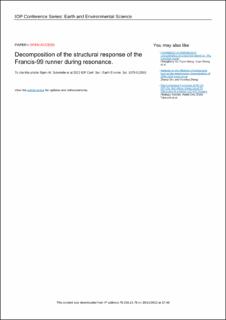| dc.contributor.author | Solemslie, Bjørn Winther | |
| dc.contributor.author | Østby, Petter Thorvald Krogh | |
| dc.contributor.author | Iliev, Igor | |
| dc.date.accessioned | 2022-12-08T11:09:30Z | |
| dc.date.available | 2022-12-08T11:09:30Z | |
| dc.date.created | 2022-11-29T18:51:35Z | |
| dc.date.issued | 2022 | |
| dc.identifier.issn | 1755-1307 | |
| dc.identifier.uri | https://hdl.handle.net/11250/3036737 | |
| dc.description.abstract | In this work, the complex structural response of the Francis-99 turbine runner is further investigated by decomposition of the output signal from previous Laser Doppler Vibrometry (LDV) measurements into the motion of each nodal diameter. During the structural measurements, the non-rotating runner was installed in the turbine pit, submerged in a non-flowing water, and excited with piezoelectric patches mounted on the hub. The patches were excited with phase shifted sinusoidal voltage to create overall excitation of the runner with a desired number of nodal diameters. The deflection of selected locations on the trailing edges were scanned with LDV, one point at a time, and the global movement was reconstructed by combining the data for all points. The Francis-99 runner has its blades bolted to an over-dimensioned hub and shroud, where the hub is not fully axi-symmetrical and has several hollows in it. This, together with the fact that one patch was found to be non-functional, is believed to have excited other ND patterns in addition to the one that was intentionally excited, therefore contaminating the movement of the trailing edges with movements that does not belongs to the excited ND. To mitigate this and create a better representation of the movement of the trailing edge, which is not affected by the bleed from other ND, the LDV signal for each excited frequency of a particular ND is post-processed using discreet Fourier transformation to decompose the motion of each nodal diameter in the range ND0 to ND7. This unveils the contribution of each nodal diameter within the output signal where a spike is seen for the excited ND in all measurements. Influence from other nodal diameters were found, where the failed patched is believed to cause a ND1 like movement. In addition the clustering of multiple eigenmodes with differing nodal diameters previously found in narrow frequency bands were also found as interfering contribution when exciting at the relevant frequencies. © Published under licence by IOP Publishing Ltd. | en_US |
| dc.description.abstract | Decomposition of the structural response of the Francis-99 runner during resonance | en_US |
| dc.language.iso | eng | en_US |
| dc.rights | Navngivelse 4.0 Internasjonal | * |
| dc.rights.uri | http://creativecommons.org/licenses/by/4.0/deed.no | * |
| dc.subject | Resonance | en_US |
| dc.subject | Experimental Study | en_US |
| dc.subject | Modal Testing | en_US |
| dc.title | Decomposition of the structural response of the Francis-99 runner during resonance | en_US |
| dc.title.alternative | Decomposition of the structural response of the Francis-99 runner during resonance | en_US |
| dc.type | Peer reviewed | en_US |
| dc.type | Journal article | en_US |
| dc.description.version | publishedVersion | en_US |
| dc.rights.holder | © 2022 The Authors | en_US |
| dc.subject.nsi | VDP::Matematikk og Naturvitenskap: 400 | en_US |
| dc.source.volume | 1079 | en_US |
| dc.source.journal | IOP Conference Series: Earth and Environmental Science (EES) | en_US |
| dc.identifier.doi | 10.1088/1755-1315/1079/1/012093 | |
| dc.identifier.cristin | 2084661 | |
| dc.source.articlenumber | 012093 | en_US |
| cristin.ispublished | true | |
| cristin.fulltext | original | |
| cristin.qualitycode | 1 | |

